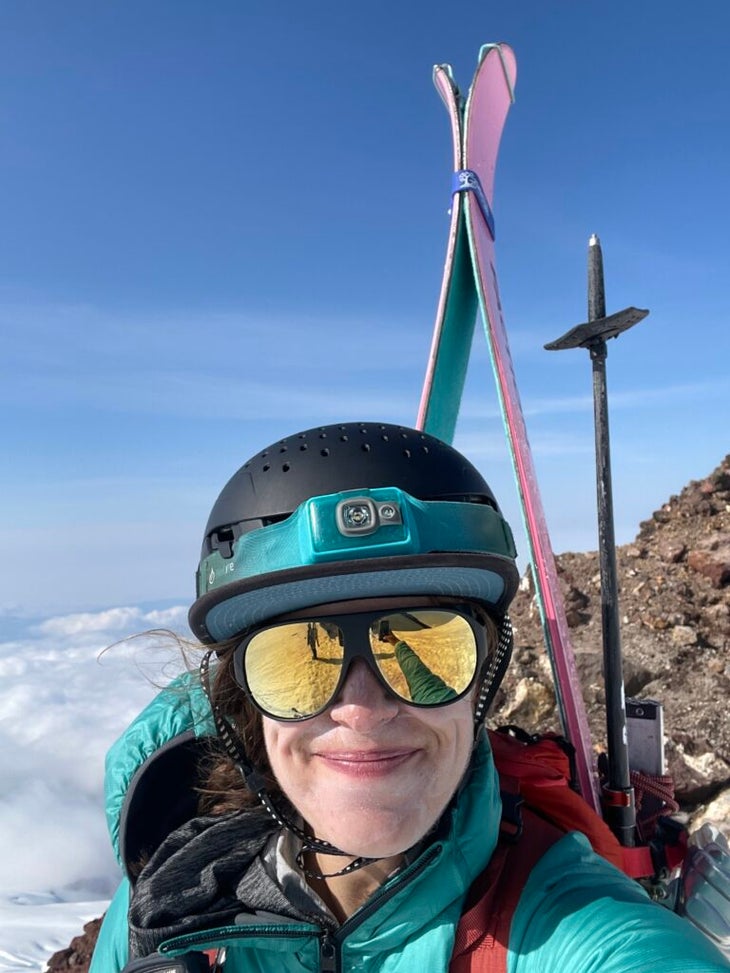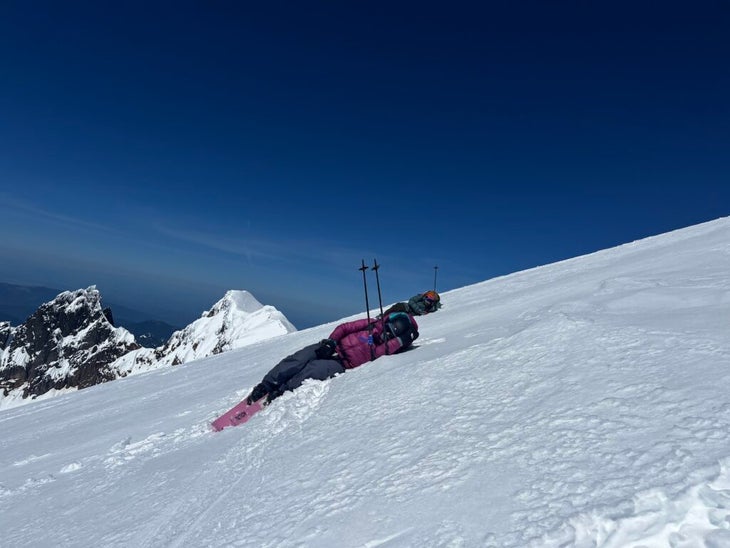Heading out the door? Read this article on the new Outside+ app available now on iOS devices for members! Download the app.
For longtime hikers and backpackers, the desire to tackle bigger, more technical mountains tends to come around eventually. Spend enough time staring at glaciated peaks from camp, and sooner or later, you’ll want to climb one yourself.
I’d been mountaineering-curious for years when I signed up for a course on Washington’s Mt. Baker last May. Along with a guide and two companions, I spent five days camped on the mountain practicing self-arrest, crevasse rescue, ropework, and other ski mountaineering skills. Our summit and ski descent on the third day was one of the hardest and most memorable accomplishments of my outdoor career—capped off by a show of the northern lights the following night. As a lifelong backpacker, here’s what I wish I knew before embarking on my first mountaineering trip.
Sunburnt nostrils are not a myth.
You may have heard this one before: Spring sun overhead and reflective snow below is a recipe for the worst sunburn of your life, even when you’re bundled up against chilly mountain winds. When you spend an extended period of time in the white expanse, you’ll have to stay more on top of sun protection than you ever do on the trail. In addition to protective clothing and dark sunglasses, invest in a high-quality, high-SPF sunscreen and lip balm, and reapply often. I kept a compact zinc-based sunscreen stick in my hipbelt pocket, and I wish I’d used it even more often—yes, even to the inside of my nose.

Snacks are everything.
Think backpacking is all about eating? Mountaineering takes it to a new level. Eating enough while exerting at altitude is challenging, especially when you’re wearing gloves, heavy winds want to rip wrappers from your hands, and your body clock is thrown off from an alpine start. But consistent fueling is especially necessary for a big climb. I’m convinced that I was only able to summit Mt. Baker because I force-fed myself a full breakfast at 2 a.m. before starting our ascent. Also, don’t underestimate the power of quick-burning fuel to stave off bonking. I was ready to quit before the final 1,000-foot summit push until my guide offered me a Clif Blok; it provided the boost I needed to make it to the top.
Your backpacking gear can pinch hit—but only to a point.
In many cases, you don’t need to shell out on all new gear for your first mountaineering trip. Lots of backpacking gear will work great, like your headlamp, navigation tools, some layers, sleeping bag, and assorted personal gear. In some cases, though, my backpacking gear didn’t quite cut it. My Jetboil Stash, for instance, is my go-to backpacking stove for how light and compact it is. But when relentless winds plagued us for five days straight, the exposed flame struggled to stay lit, and I was acutely aware of the lack of trees and other natural protection in the alpine. I envied my companions’ stoves with built-in wind protection, like the MSR Windburner. When packing for your first mountaineering trip, think about the difference in environment to determine what swaps to make from your usual kit.

Don’t skimp on the stove fuel.
Backpackers might be tempted to go ultralight on the mountain, but in some cases, you’ll need to pack heavier than you do on the trail. Stove fuel is one of those categories. Melting snow for water—especially in a windy environment—will use a lot more fuel than a typical backpacking trip where you are only cooking food. I had fuel anxiety for my entire mountaineering course, especially because consistent winds caused my stove to run less efficiently than usual. Packing a small backup canister would have been worth the extra weight. You can maximize fuel efficiency with some handy tricks, but err on the side of caution when it comes to calculating how much fuel to bring. Running out could mean going thirsty.
It’s also useful to keep in mind that making water is a much more significant camp chore when mountaineering than it is on a backpacking trip. Melting snow for water takes a lot longer than filtering, and you’ll have to stay on top of it in order to stay hydrated.
Sleep is important, but the body is resilient.

I was so anxious about my first alpine start, even when my guide waxed poetic about climbing under the stars and watching first light illuminate the mountains around us. The night before our summit push, gale-force winds flattened our tents and stole any notion of a good night’s rest. I must not have gotten more than two hours of shut-eye before we began climbing at 2 a.m. As someone who sleeps strictly eight to nine hours at home, I couldn’t imagine summiting without proper rest. But my body surprised me—ample snacks, fresh mountain air, and the exhilaration of scaling a glacier in the dark kept me alert. Although the climb sapped every ounce of energy I had, lack of sleep wasn’t a problem. (A slopeside nap while we waited for the snow to soften on our ski down didn’t hurt, either.)
Backpackers make great mountaineers.
My biggest takeaway from learning crevasse rescue: Critical thinking and problem solving skills are more important than memorizing rope systems. Of course, rope skills and knot-tying are crucial, but the ability to improvise and react appropriately in a variety of scenarios will help you get out of a sticky situation on the mountain. As backpackers, we’re already primed to tap into this mindset. Trust your instincts, stay aware of your surroundings, and enjoy all the magic that big mountains have to offer.
